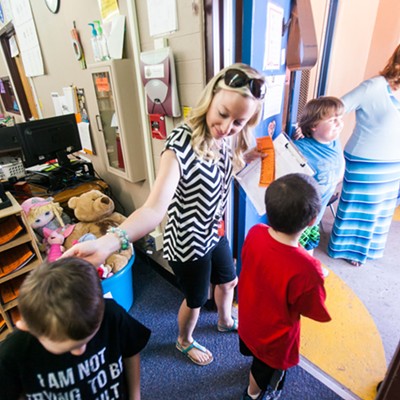When you teach at a public high school, you come to expect certain kinds of teenage rebellion, but a graphic death threat written during class with a Sharpie in large capital letters across the top of a desk was above and beyond what Ledbetter felt like she or any teacher should have to tolerate. "I will kill you," the Jan. 16 message said, with added violent flourishes and expletives. "I hope you read this."
From there, Ledbetter found herself engaged in a battle that highlights the core problem in public education: When the emphasis on leaving no child behind means keeping students who couldn't care less about learning in the classroom, the classroom no longer becomes a place where learning is valued. When students no longer suffer the consequences of their actions, the classroom becomes merely a holding pen with flimsy walls.
Once Ledbetter identified the guilty student (which proved difficult--no teacher had any written work from the student to use as a handwriting sample), it took the school administration nearly two days to address the situation. The student was arrested and suspended for nine days--the Tucson Unified School District's maximum pending a formal hearing. Ledbetter assumed the student would be suspended long-term; all TUSD disciplinary procedures center on the idea that the educational process shall not be disrupted. Threatening to kill your English teacher seemed an obvious disruption of the educational process.
But when the nine days were up, the student was back on campus. Some other English teachers had expressed concern about having the student in their classes, so he wasn't assigned to an English class. Ledbetter went to the TV news media in hopes of inciting action. The teacher's union suggested she get a whistle. The student was banned from the English hallway by the principal, but none of the monitors or other administrators enforced the ban, or even knew it was in place.
When Ledbetter saw the student hanging out near her classroom, she contacted the principal, and the student was suspended again. His parents subsequently withdrew him from the school.
Even though the situation was eventually resolved, Ledbetter had to continually defend her desire for a safe classroom, for herself and her students: something considered fundamental to the educational process. Furthermore, she wanted the student to learn that threatening to kill someone is not something that anyone should be allowed to get away with. But Ledbetter needed to circumvent the disciplinary system to accomplish what should have been done in the first place--and only after weeks of struggle.
This incident epitomizes the horrific split between what the public thinks goes on in the schools and what actually happens. The strategic goals outlined by the TUSD Governing Board repeatedly maintain that the classroom is "the core of successful education." This incident violates everything those strategic goals stand for. When the classroom becomes a place where not even the teacher feels safe, and when the school fails to quickly and effectively deal with that problem, the classroom is no longer at the core of a successful education. When anyone can get away with anything in the classroom, what are we really teaching?
"Doesn't my right for a safe workplace come before his right to have a place to socialize?" wrote Ledbetter in an e-mail to a fellow Catalina English teacher.
The fundamental flaw in the public education system is the very conception and value of the classroom itself. If the classroom is no longer a place where education and learning are most important, then everything begins to break down.
At a school like Catalina, where the building itself is crumbling under years of neglect and mismanagement, the classroom is no longer a place of learning. It's a place where constant disruptions in the educational process make it clear to the students that learning is not valued. When a student threatens a teacher, and the minimum is done, the lesson that gets taught is this: We don't care what happens in the classroom. And that is a very scary lesson.











